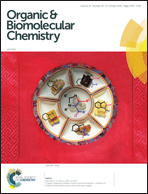Phosphinatophenylporphyrins tailored for high photodynamic efficacy†
Abstract
The development of effective photosensitizers is particularly attractive for photodynamic therapy of cancer. Three novel porphyrin photosensitizers functionalized with phosphinic groups were synthesized and their physicochemical, photophysical, and photobiological properties were collected. Phosphinic acid groups (R1R2POOH) attached to the porphyrin moiety (R1) contain different R2 substituents (methyl, isopropyl, phenyl in this study). The presence of phosphinic groups does not influence absorption and photophysical properties of the porphyrin units, including the O2(1Δg) productivity. In vitro studies show that these porphyrins accumulate in cancer cells, are inherently nontoxic, however, exhibit high phototoxicity upon irradiation with visible light with their phototoxic efficacy tuned by R2 substituents on the phosphorus centre. Thus, phosphinatophenylporphyrin with isopropyl substituents has the strongest photodynamic efficacy due to the most efficient cellular uptake. We demonstrate that these porphyrins are attractive candidates for photodynamic applications since their photodynamic efficacy can be easily tuned by the R2 substituent.

- This article is part of the themed collection: Mechanistic, computational & physical organic chemistry in OBC


 Please wait while we load your content...
Please wait while we load your content...